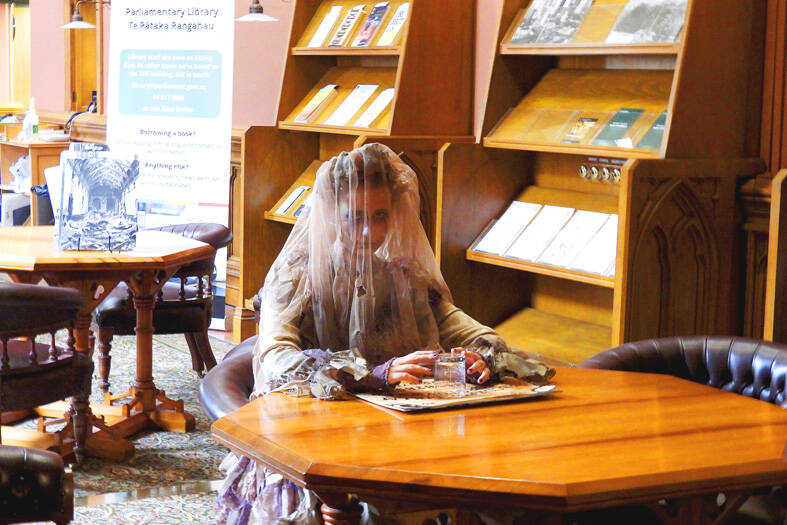A veiled woman burst screaming from an elevator. The small crowd gathered in a basement corridor of New Zealand ’s parliament drew back nervously.
Their guide, wearing a trailing, white gown, smiled sweetly.
“You’re welcome to take the elevator,” she said.

Photo: AP
Nobody did.
Mysterious deaths, unexplained noises and late-night apparitions are not the usual fodder of daily tours offered at the parliament buildings in Wellington. However, after hours on Thursday, guides donned Victorian-era garb to regale visitors with the precinct’s less savory history — “mostly factual” tales of real-world tragedy and paranormal lore that have grown established among political staffers through decades of colorful retelling.
The history of parliament’s stately gothic library is particularly rich in woe. Constructed in the late 19th century and feared by some of parliament’s night shift security guards and cleaners, it has survived two fires, a flood and being overrun by feral cats.

Photo: AP
“This is your last chance to back out,” Lisa Brand, her face dripping with fake blood, told the group on Thursday’s tour — a recent initiative and one embraced by the visitors’ center staff with gusto.
Walking through a cavernous parliamentary atrium, the guide let out a hair-raising scream that echoed up to the open windows of lawmakers’ offices. It explained why the so-called spooky tours are reserved for weeks when parliament is not in session.
The Parliamentary Library is a gloomy and ornate building where stained-glass windows and crystal chandeliers dimly reveal wrought iron bannisters and Venetian decor. Designed by Thomas Turnbull and completed in 1899, it remains in use by staff seeking information or some slightly eerie peace and quiet.
When the visitors arrived, they were greeted by spectral figures who shrieked as they glided down staircases beneath the portraits of former head librarians and New Zealand prime ministers. Tour guides told a hushed audience that the library was imperiled by a savage storm that struck Wellington in 1968 — sinking a passenger ferry in the harbor with the deaths of 53 people.
The tempest lashed parliament, too, tearing out skylights and prompting librarians to climb onto the roof as they tried to protect the books, said a guide, who sported Victorian garb and dark shadows under her eyes.
“For mysterious and unknown reasons they did this in their underwear,” she told the visitors. “There seems to be a history of people losing their pants here in this parliament.”
“I haven’t even started on the politicians,” the guide added, with relish.
Eventually the tour turned to lawmakers. Well-known in New Zealand is the story of William Larnach, a politician who in 1898 was found dead in a room at parliament with a revolver in his hand while experiencing financial and family strife.
Some claim that Larnach’s ghost remains in the building. However, his skull was stolen — and in 1972 was rediscovered in a college student’s bedroom.
Another spirit reported to linger is that of the first full-time librarian, Ewen McColl, whose death was partly attributed by some official sources to overwork.
As the tour descended to the building’s basement, the ceilings grew low and the corridors narrow. Frantic banging resounded from an apparently locked room.
The subterranean floors are home to an archive containing the historical and esoteric.
It is also the site of some of the building’s strangest reported occurrences, tour guides said.
Urban legends passed down by staff include stories of hands reaching out from the stacks, songs emanating from empty bathrooms, the apparition of a ghostly woman in a mirror, and locked doors swinging open. More earthly horrors included a cat, and subsequent flea, infestation in 1977.
After one last fright, visitors emerged slightly shaken into parliament’s near-empty lobby as darkness fell.
The tour was “a bit spookier than I expected,” said Holly Masters, who had last visited parliament as a child. “There was quite a few deaths here that I did not expect to find out about.”
Another visitor, Sally Giles, said she was fascinated to learn the stories of those who worked and died in the precinct “and what they’ve left behind and how that surfaces every now and then.”

PARLIAMENT CHAOS: Police forcibly removed Brazilian Deputy Glauber Braga after he called the legislation part of a ‘coup offensive’ and occupied the speaker’s chair Brazil’s lower house of Congress early yesterday approved a bill that could slash former Brazilian president Jair Bolsonaro’s prison sentence for plotting a coup, after efforts by a lawmaker to disrupt the proceedings sparked chaos in parliament. Bolsonaro has been serving a 27-year term since last month after his conviction for a scheme to stop Brazilian President Luiz Inacio Lula da Silva from taking office after the 2022 election. Lawmakers had been discussing a bill that would significantly reduce sentences for several crimes, including attempting a coup d’etat — opening up the prospect that Bolsonaro, 70, could have his sentence cut to

A powerful magnitude 7.6 earthquake shook Japan’s northeast region late on Monday, prompting tsunami warnings and orders for residents to evacuate. A tsunami as high as three metres (10 feet) could hit Japan’s northeastern coast after an earthquake with an estimated magnitude of 7.6 occurred offshore at 11:15 p.m. (1415 GMT), the Japan Meteorological Agency (JMA) said. Tsunami warnings were issued for the prefectures of Hokkaido, Aomori and Iwate, and a tsunami of 40cm had been observed at Aomori’s Mutsu Ogawara and Hokkaido’s Urakawa ports before midnight, JMA said. The epicentre of the quake was 80 km (50 miles) off the coast of

China yesterday held a low-key memorial ceremony for the 1937 Nanjing Massacre, with Chinese President Xi Jinping (習近平) not attending, despite a diplomatic crisis between Beijing and Tokyo over Taiwan. Beijing has raged at Tokyo since Japanese Prime Minister Sanae Takaichi last month said that a hypothetical Chinese attack on Taiwan could trigger a military response from Japan. China and Japan have long sparred over their painful history. China consistently reminds its people of the 1937 Nanjing Massacre, in which it says Japanese troops killed 300,000 people in what was then its capital. A post-World War II Allied tribunal put the death toll

A passerby could hear the cacophony from miles away in the Argentine capital, the unmistakable sound of 2,397 dogs barking — and breaking the unofficial world record for the largest-ever gathering of golden retrievers. Excitement pulsed through Bosques de Palermo, a sprawling park in Buenos Aires, as golden retriever-owners from all over Argentina transformed the park’s grassy expanse into a sea of bright yellow fur. Dog owners of all ages, their clothes covered in dog hair and stained with slobber, plopped down on picnic blankets with their beloved goldens to take in the surreal sight of so many other, exceptionally similar-looking ones.